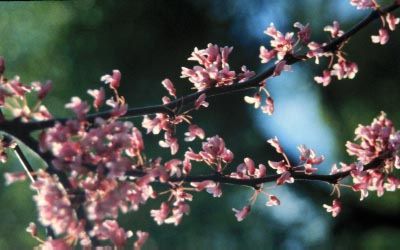Genus: Cercis

Cercis canadensis L. - Redbud
Photo © by Peter Nelson
Taken at the Brooklyn Botanic Garden, NY, 1991.
Taken at the Brooklyn Botanic Garden, NY, 1991.
Nomenclature
Cercis L., Sp. Pl. 374. 1753. Gen. Pl. 176. 1754. Siliquastrum Duhamel, Traité Arbr. Arbust. 2: 263. 1755. LECTOTYPE: Cercis siliquastram L. designated by Britton & Brown (1913).List of Cercis Species
References to Cercis
- Afanasiev, M. 1944. A study of dormancy and germination of seeds of Cercis canadensis. J. Agric. Res. 69: 405-20.
- Ames, O. I. 1939. Survey of hurricane damage at Mount Auburn Cemetery, Cambridge, Massachusetts. Arborist's News 4(1): 5-6.
- Anonymous 1974. Redbud, Cercis canadensis: pea family (Leguminosae). Morton Arbor. Quart. 10(4): 60-1.
- Atchison, E. 1949. Chromosome numbers in the Leguminosae. IV. Chromosome numbers and geographical relationships of miscellaneous Leguminosae. J. Elisha Mitchell Sci. Soc. 65: 118-22.
- Blackwell, W. H. 1990. An explanation for the discrepancy in the chromosome count of the redbud (Cercis canadensis), Leguminosae. Sida 14(1): 7-11.
- Carpenter, S. B.; Smith, N. D. 1979. Variation in shade leaf thickness among urban trees growing in metropolitan Lexington, Kentucky. Castanea 44: 94-8.
- Cathey, H. M.; Campbell, L. E. 1975. Security lighting and its impact on the landscape. J. Arboric. 1: 181-187.
- Curtis, W. F. 1977. Chromosome counts in Grielum and Cercis. Ann. Missouri Bot. Gard. 63(2): 379-80.
- Davies, W. J.; Kozlowski, T. T. 1974. Stomatal responses of five woody angiosperms to light intensity and humidity. Canad. J. Bot. 52(7): 1525-34.
- Davis, C. C. et.al. 2002. Phylogeny and biogeography of Cercis (Fabaceae): evidence from nuclear ribosomal ITS and chloroplast ndhF sequence data. Syst. Bot. 27: 289-302.
- Donselman, H. M.; Flint, H. L. 1982. Genecology of eastern redbud (Cercis canadensis). Ecology 63: 962-971.
- Echternach, J. L.; Rose, R. K. 1987. Use of woody vegetation by beavers in southeastern Virginia USA. Virginia J. Sci. 38: 226-232.
- Fordham, A. J. 1965. Germination of woody legume seeds with impermeable seed coats. Arnoldia (Jamaica Plain) 25: 1-8.
- Harris, J. A. 1910. On the relationship between the length of the pod and fertility and fecundity in Cercis. Bot. Gaz. 50: 117-27.
- Harris, J. A. 1914. On the relationship between the number of ovules formed and the number of seeds developing in Cercis. Bull. Torrey Bot. Club 41: 243-56.
- Heaslip, M. B. 1959. Effects of seed irradiation on germination and seedling growth of certain deciduous trees. Ecology 40(3): 383-8.
- Hopkins, M. 1942. Cercis in North America. Rhodora 44(522): 193-211.
- Kozlowski, T. T. 1980. Responses of shade trees to pollution. J. Arboric. 6: 29-40. (Sulphur dioxide & ozone)
- McClendon, J. H.; McMillen, G. G. 1982. The control of leaf morphology and the tolerance of shade by woody plants. Bot. Gaz. 143(1): 79-83.
- McDougall, W. B. 1921. Thick-walled root hairs of Gleditsia and related genera. Amer. J. Bot. 8: 171-5.
- Nichols, G. E. 1923. Cercis canadensis in Connecticut. Rhodora 25: 203-4.
- Owens, S. A.; Ewers, F. W. 1991. The development of cauliflory in redbud, Cercis canadensis (Fabaceae). Canad. J. Bot. 69: 1956-63.
- Owens, S. A.; Ewers, F. W.; Flegler, S. L.; Klomparens, K. L. 1995. Architecture of cauliflory in the genus Cercis (Fabaceae: Caesalpinioideae). Canad. J. Bot. 73(8): 1270-82.
- Owens, S. A.; Fields, P. F.; Ewers, F. W. 1998. Degradation of the upper pulvinus in modern and fossil leaves of Cercis (Fabaceae). Amer. J. Bot. 85: 273-84.
- Owens, S. J.; Lewis, G. P. 1996. Stigma morphology in the Leguminosae: The wet, papillate (WP) stigma in Caesalpinioideae. Kew Bull. 51(1): 119-31.
- Plummer, G. L. 1954. Cercis canadensis L.: an ecological life history. Ph.D. Dissertation Purdue University, West Lafayette, IN,
- Plummer, G. L.; Lindsey, A. A. 1954. On the occurrence of redbud in Indiana. Proc. Indiana Acad. Sci. 64: 79-87.
- Reeder, J. R. 1951. A further note on Cercis canadensis in Connecticut. Rhodora 53(634): 246-7.
- Rembert, D. H. 1969. Comparative megasporogenesis in Caesalpiniaceae. Bot. Gaz. 130(1): 47-52.
- Robertson, K. R. 1976. The redbuds. Arnoldia (Jamaica Plain) 36: 37-49.
- Robertson, K. R.; Lee, Y. T. 1976. The genera of Caesalpinioideae in the southeastern United States. J. Arnold Arbor. 57: 1-34.
- Slade, B. 1957. Leaf development in relation to veination as shown in Cercis siliquastrum L., Prunus serrulata Lindl. and Acer platanus. New Phyt. 56: 281-300.
- Sullivan, J. 1994. Cercis canadensis. ()
- Tucker, S. C. 2002. Floral ontogeny of Cercis (Leguminosae: Caesalpinioideae: Cercideae): Does it show convergence with Papilionoids? Int. J. Plant Sci. 163: 75-87.
- Werner, P. A.; Harbeck, A. L. 1982. The pattern of tree seedling establishment relative to staghorn sumac cover in Michigan old fields. Amer. Midl. Naturalist 108: 124-32.
- Wunderlin, R. P. 1976. Enumeration and typification of genera in the tribe Cercideae. Rhodora 78(816): 750-60.
- Wunderlin, R.; Larsen, K.; Larsen, S. S. 1987. Reorganisation of the Cercideae (Fabaceae: Caesalpinioideae). Biol. Skr. 28: 1-40.